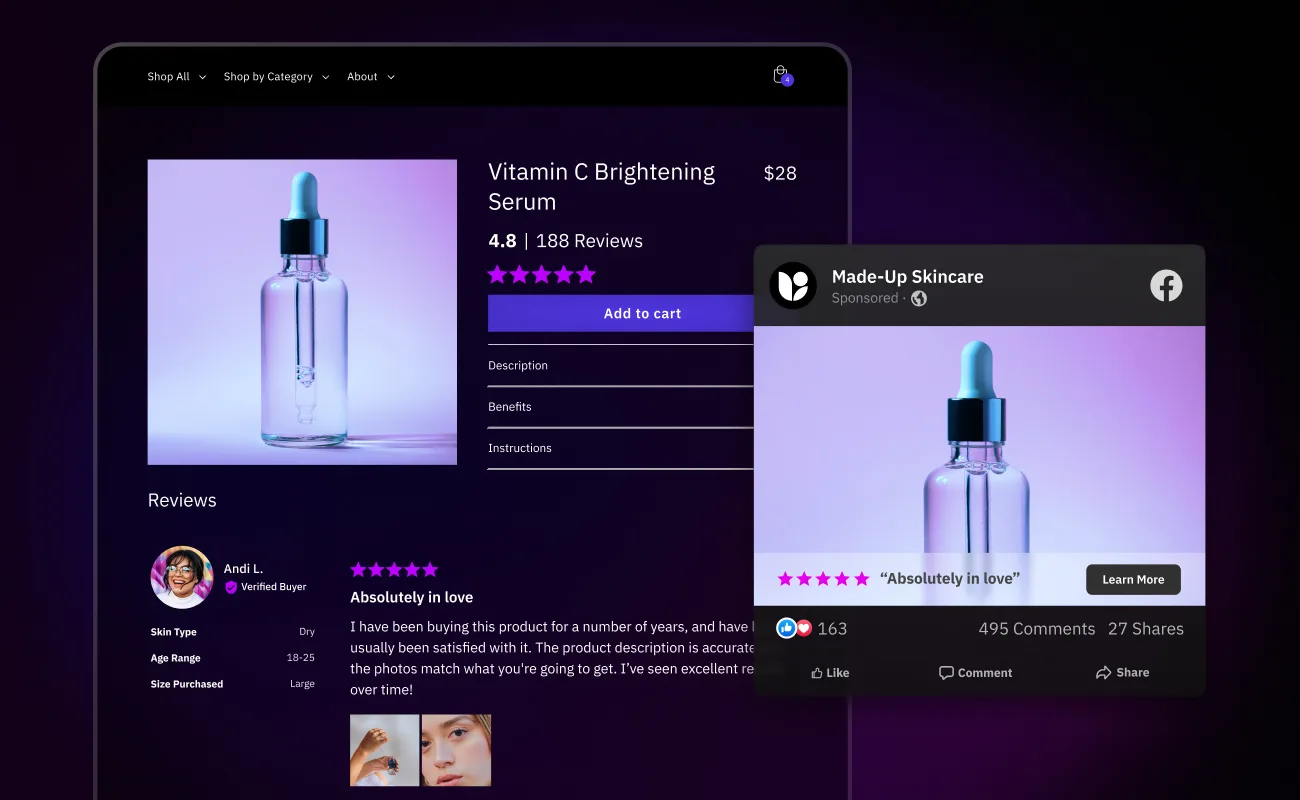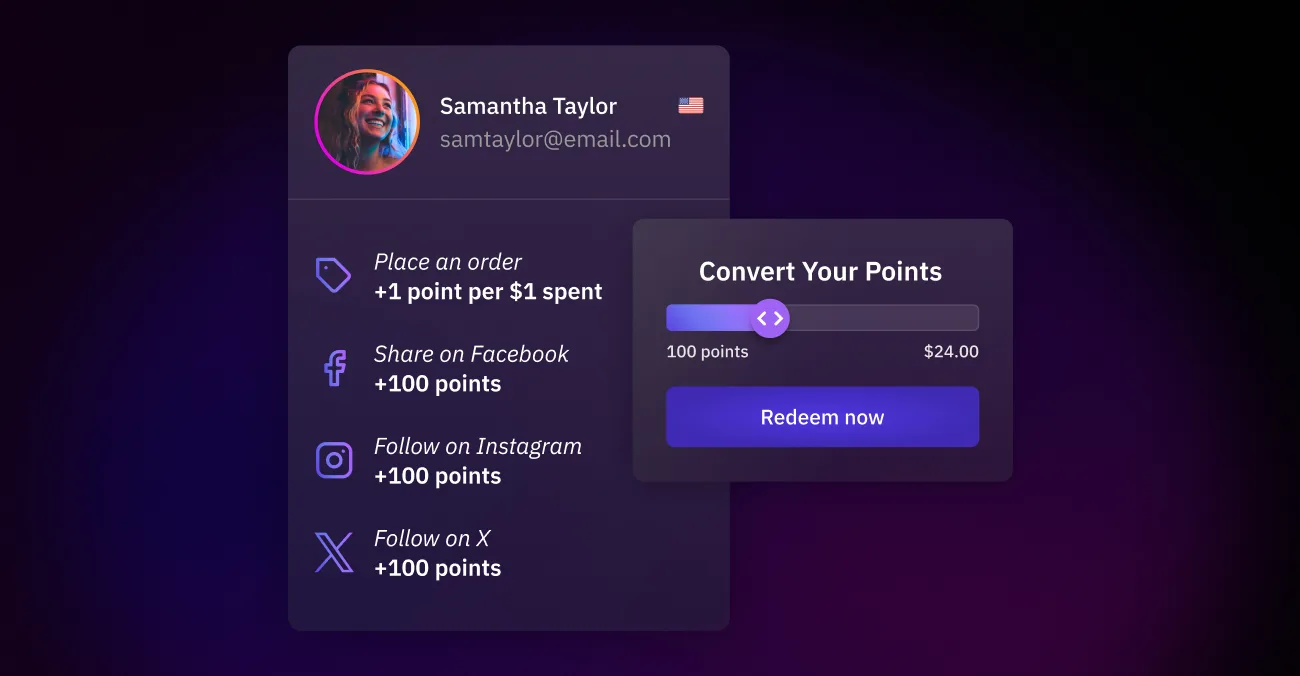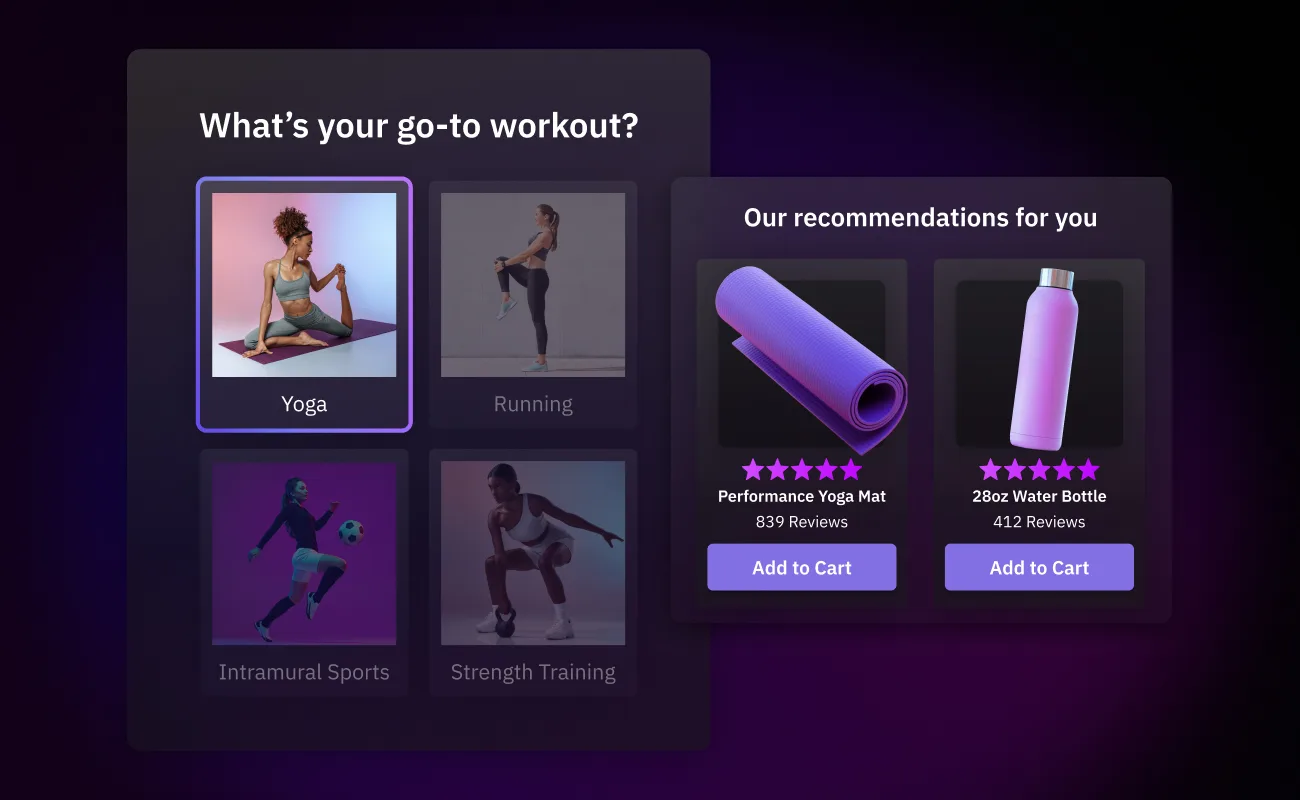
- Ecommerce Marketing
- Integration
- Partners
- Product
Supercharge Customer Engagement with Okendo & Klaviyo
Guest Author | Apr 21, 2025
May 8, 2024 | 17 minute read

Matt Goodman
Co-founder, CEO
This article provides valuable insights into ecommerce conversion rate optimization (CRO), guiding you through 15 impactful tips to enhance your website’s conversion rates including leveraging customer reviews and implementing loyalty programs. Each tip offers actionable strategies to improve various aspects of your brand.
Oftentimes, brands focus their marketing efforts on acquiring new customers with strategic tactics and a close focus on paid marketing budgets only to forget about and spend less time optimizing their ecommerce conversion rate (CRO). Before you spend money on driving traffic for your brand, consider how ecommerce conversion rate optimization can reduce costs, improve the customer experience, and build healthier, more sustainable growth.
With rising acquisition costs, it becomes more important for brands to optimize the traffic that does come to their ecommerce sites. Focusing on CRO gives brands another lever that they can pull to increase revenue without having to spend money on paid media or develop involved marketing campaigns. It puts a greater focus on existing customers or traffic that is already coming to the site. This guide explores 15 helpful tips for your brand to implement to increase ecommerce conversion rate on your website.
Your brand can increase ecommerce conversion rate in a number of ways. Since CRO is comprehensive and should be used throughout the customer journey, conduct an audit of your website and understand where most customers drop off or bounce in the experience funnel. This will assist in identifying where you should concentrate your CRO efforts. Also, use these 15 tips:
Improving ecommerce CRO is a multi-faceted task, requiring you to make lots of small tweaks and enhancements across various parts of your website. The gradual accumulation of these small improvements can make a world of difference to the conversion rate of your store.
Here is a an in-depth analysis of each of our top 15 ecommerce CRO tips:
Utilizing reviews to add social proof is one of the most effective ecommerce growth strategies there is, as it allows brands to engage existing customers while also optimizing conversion rates for new customers. It uses existing customer feedback as a testimonial or an endorsement of the product’s quality or benefits.
Customer reviews with UGC help increase conversion rate because they are more trustworthy than a brand’s advertisements or curated marketing efforts. A customer is far more likely to trust another customer who has no concern in promoting a product rather than your brand who is trying to make a sale.
The quality of UGC is crucial for strong social proof. It reflects positively on your brand, providing genuine insights into your product’s value and utility. High-quality UGC is relevant, authentic, clear, engaging, and visually appealing, enhancing trust and credibility with your audience.

Understand that customers who shop online sometimes have not experienced the brand’s brick-and-mortar locations or had any previous interaction with the brand. To ensure a higher level of trust from these new customers, incorporate trust signals and security measures throughout the experience.
Trust signals such as displaying privacy, return, or account policies help the customer understand that the online brand is legitimate, has safeguards in place, and cares about improving customer experience. Additional trust signals include a live chat service or call center so that customers can speak with a human who can help should they have any issues with their experience.
Your brand is most vulnerable to losing customers when money is about to exchange hands. To ensure customers do not experience hesitation during the checkout process, focus efforts on offering multiple payment methods or payment installations and simplifying the checkout flow.
If a checkout flow involves too many steps or inputting too much information, customers can get frustrated or bored and bounce from the site. Make sure your website requests only information that is necessary to reduce the number of steps customers need to take to make a purchase. Further, reduce the barriers to purchase by offering many different payment methods or payment installments so customers can pay with flexibility and less customers are barred from purchasing due to affordability.
Loyalty programs incentivize customers to return for repeat purchases for a reward or discount in exchange for their loyalty. They are also an effective tool for conversion rate optimization because they encourage customers who have had previous experiences with the brand (and therefore already understand the site experience) to return. This thereby creates a more qualified customer base with higher purchase intent.

Focus on even the small details like call-to-action buttons (CTAs) to optimize conversion rates. CTAs might seem insignificant, but in ecommerce they play a more important role than you would expect. A CTA prompts a customer to click to another page. Examples of generic CTAs include “Sign Up,” “Shop Now,” or “Learn More.”
CTAs offer the customer a short preview of the page they are clicking into, and should therefore be relevant to the page they are describing to prevent miss-clicks. For example, if a CTA says “Shop Home” but the page does not contain home products or the customer misunderstands the CTA and expects to be taken back to the homepage, they might get frustrated and bounce from the site.
Ensure your CTAs are accurately descriptive of the page the customer will be visiting and consider adding more detail (“Shop Decor” instead of just “Shop Now”) to avoid friction in the experience.
The goal of conversion rate optimization is to encourage customers to make a purchase as efficiently as possible. When it comes to providing product information, high-quality product images and videos can provide more information in three seconds than product descriptions and copy can provide in 30 seconds.
To improve ecommerce conversion rate with a focus on the PLP and PDP, ensure your product imagery is clear, high-quality, and shows multiple angles of the product. Consider including on-image dimensions or additional features and benefits displayed visually to increase the customer’s understanding of the product. When customers are supplied with sufficient product knowledge, they are much more likely to understand what they are purchasing and proceed to the checkout flow.
Product descriptions serve to enhance and support your brand’s product imagery for improved product information. Product descriptions should be customer-facing, features and benefits-focused rather than overloaded with technical jargon.
For example, instead of describing faux leather as “synthetic manmade material,” or “polyurethane” (even though this is an accurate description of the material), change the verbiage to “faux smooth leather” or “vegan leather” to explain the customer-facing details or tout the sustainability benefits of faux leather. Product descriptions should be concise, informative, clear, and support the customer decision making process.
The infrastructure or navigation of your ecommerce site is important for helping customers find what they are looking for in their visit. Site navigation should be simple and reflective of how your customer shops for an intuitive product discovery experience. For example, if your customer typically shops your brand by product category, but your navigation is set up for shopping by color, the customer may become confused and bounce from the site assuming your brand does not have what they are looking for.
To improve site navigation, research how your customers prefer to shop and mirror their behavior with your navigation structure. Leverage onsite search data or traffic data to understand your customers’ behavior and interaction with your site. Use filters and additional CTAs where appropriate to enhance product discovery.
In your office or remote home office, you might naturally focus on your brand’s desktop site experience, but considering the mobile experience is very important for CRO efforts. With mobile traffic increasing and often representing the majority of ecommerce purchases, brands should consider prioritizing the mobile experience over the desktop experience.
For any change or CRO strategy your brand implements, make sure it first improves the mobile experience and is formatted for a vertical screen rather than a desktop. Consider the user experience for touchscreens rather than a desktop cursor, understand how your top navigation translates to left-hand navigation, and keep in mind that “above the fold” content is different for mobile shoppers and desktop users.
When customers create an account with your brand, you are much more able to tailor and simplify the customer experience to their preferences and needs thereby increasing the conversion rate. When an account is created, your customer can have a speedier pre-filled checkout flow. It will also give you, as the brand, insights into customer behavior and preferences so that you may personalize the experience.
Further, you’ll get an indication of customer loyalty and high intent to purchase. Add CTAs with reward-based incentives for customers to sign up and create an account so that you can double down on your CRO efforts to create a frictionless experience.
When customers utilize onsite search and filters, they are oftentimes looking for something specific and therefore have a much higher intent. By implementing search and filtering you are creating an easier experience for these high-intent customers and improving product discovery and navigation.
Ensure you have filters available for how your customer prefers to refine their product search. For example, if customers prefer to shop by price, create a price range filter so that they may identify qualifying products in their price range. For the search experience, ensure that your search results are relevant, are reflective of how your customer searches, take typos into account, and have quick load times for these convenience-focused customers.
As mentioned earlier, the checkout flow is where brands are at the greatest risk of losing potential customers and when conversion rate optimizations are most critical. To improve the checkout flow, focus on the payment and shipping process.
You can offer multiple payment methods with quick-fill tools or mobile wallets or provide installment options. Both of these increase affordability and convenience, which can help increase the number of qualified buyers. To streamline the shipping process consider offering delivery insurance, buying online pick-up in-store programs, or buying online pick-up anywhere (at participating retailers) to increase comfort and trust in the online shopping experience.
If your checkout optimizations do fail and some potential customers end up abandoning their shopping carts, having an abandoned cart recovery strategy in place can act as a CRO safeguard and bring customers back into the purchase funnel.
Cart abandonment recovery strategies usually involve lifecycle marketing or engaging customers through email and SMS to remind them of the product they were considering. Some abandoned cart strategies offer tiered discounts which depend on the customer’s level of intent to incentivize them to return to the purchase flow. Having an automated campaign for abandoned carts in place can effectively optimize conversion rates especially since these customers are some of the closest to making a purchase.
In traditional brick-and-mortar stores, A/B testing is either very difficult or impossible to conduct. On ecommerce sites, however, A/B testing can be leveraged to gain customer insights, establish best practices, and improve the user experience for CRO.
Take advantage of the nature of an ecommerce site and make sure you are constantly testing different elements of the experience. Simple changes like enlarging color swatches, adding CTAs, bolding fonts, or repositioning buttons can have a drastic impact on conversion rate and incremental revenue. To level up your A/B testing efforts, target customer segments (new customers vs. returning customers for example) and create A/B tests to determine how customer cohorts prefer to shop.
Product recommendation quizzes are an effective brand-building tool for engaging customers, gaining insights, and personalizing the experience thereby improving conversion rates. A recommendation quiz is an interactive tool that prompts customers to fill out a quiz for personalized product recommendations. Customers who interact with this type of onsite content are inherently engaged and high-intent, therefore catering to these customers can help improve your overall CRO strategy.
Use the data and results of these tools to roll out additional strategies throughout the customer experience, recommend products you know the customers who take the quiz would be interested in and would suit their needs, and inspire trust and brand loyalty with an interactive and personalized tool.

Olivia Grant, Growth & Partnerships Director at Growth Gurus, says “Quizzes engage customers by providing a personalized shopping experience, precisely aligning product recommendations with individual preferences and needs.”
This targeted approach not only simplifies decision-making for customers but also significantly boosts conversion rates by making their choices feel uniquely tailored and directly relevant. We’ve found in addition to the increased conversion rate, customers who enter through product-led quizzes have a significantly higher AOV than those who don’t. Demonstrating the true value of incorporating these quizzes in the customer journey.”
Okendo Quizzes offers brands the ability to set up quizzes for their online store that will support conversion rate optimization efforts. Okendo quizzes are fully customizable, easy to set up, aid in product discovery, and create an experience that feels tailored and personalized to the individual online shopper.
Ecommerce conversion rate optimization (CRO), is the practice of making adjustments to the onsite experience in order to increase conversion rates. Instead of focusing efforts on acquiring new customers, it focuses on the customer journey domestic to the brand’s website domain.
Conversion rate optimization efforts can be focused on taxonomy and navigation, user-generated content (UGC), user experience (UX), the checkout process, or even details such as CTAs or payment methods. It attempts to make it as easy as possible for a customer to locate what they are looking for on the site and checkout before they bounce or become lost traffic.
Focusing on ecommerce conversion rate optimization is important because it has ripple effects and implications throughout your operation. Not only does it inspire brand loyalty and create a more positive customer experience, but it can also lower CPA costs and affect the long-term viability of your online brand.
Ecommerce conversion rate is a user experience that is vitally important to an ecommerce brand’s success, but also very easy to calculate. To calculate your online store’s conversion rate, follow this formula: Conversions/Traffic Sessions x 100%.
Conversions refer to transactions, purchases, or subscriptions (for subscription-based DTC brands). Traffic sessions refer to visits to your website within a period of time (depending on your session parameters, if a customer revisits your site within 30 minutes, this could still be considered one traffic session).
The average Shopify conversion rate is 1.4% meaning roughly only 1 in 100 traffic sessions results in a conversion or transaction. A “good” conversion rate, however, depends on your product vertical and customer base.
Big-ticket or high AUR product categories, for example, will have a naturally lower conversion rate since they require more research and comparison on the customer’s part before making a purchase. In contrast, convenience or impulse products will have a higher conversion rate because the perceived risk is lower for more customers.
As you begin your CRO efforts, be sure to maintain a customer-first mentality and prioritize the most meaningful elements to improve the overall customer experience and thereby conversion rates. Be aware of these four CRO mistakes as you start to concentrate and focus your efforts.
Just because a specific strategy is a CRO best practice does not mean it is the best strategy for your customer. Listening to customer feedback is key to improving conversion rates since your audience is actively telling you what they want and practically giving you a playbook on how to earn their dollar.
Take advantage of surveys, zero-party data, and customer reviews requests to constantly have a finger on the pulse of your customer base. These can give you some incredibly valuable insights as for how to improve customer experience further.
When it comes to running an ecommerce brand, data is your greatest friend. Unlike traditional brick-and-mortar stores, ecommerce sites can measure almost every interaction with a brand and have a wealth of data points to leverage, such as customer loyalty metrics. Use the nature of ecommerce to your advantage to discover where in the funnel conversion rates could use the most improvement or when the customer experiences the most friction.
Instead of treating CRO as one-size-fits-all, get more granular with your efforts and add in a personalization strategy. Use A/B testing, customer data, and customer feedback to understand which CRO strategies work for different customer segments and incorporate your findings into your overall strategy. Without personalization, CRO efforts can be ineffective and even seem gimmicky or inauthentic to the brand.
Adding features and content to your site can seem like it would always improve conversion rates, but if your strategies slow download times, your efforts could be rendered useless. CRO strategies should work in tandem with site speed for the most optimal customer experience. Without fast load times, customers might bounce before they even experience your personalized CRO strategies and improved customer experience.
Creating an ecommerce conversion rate optimization strategy is integral to long-term viability, sustainable growth, and continued success of your DTC brand. Consider implementing a few of these tips to start and expand your efforts as you see incremental revenue and the impacts on brand loyalty, reduced costs, and higher customer lifetime values. Book a demo with Okendo to discover how Okendo can help improve your brand’s CRO strategy.
CRO stands for Conversion Rate Optimization and refers to the practice of improving the customer experience to encourage customers to make purchases or conversions. In short, CRO aims to increase the number of sessions that result in a transaction thereby increasing revenue.
Put simply, brands can optimize a website for conversions by making it as easy as possible for a customer to find what they are looking for and make a purchase. DTC brands should consider the full experience from start to finish and implement CRO strategies for each and every step of the purchase funnel.
An optimal conversion rate depends on your DTC brand’s product vertical. While the average Shopify store conversion rate is 2.5%, a higher-than-average conversion rate does not necessarily mean that your conversion rate is optimal. Continue to optimize your ecommerce conversion rate with the tips from this article.
Shopify stores can increase conversion rates in many ways. Instead of implementing one strategy for all customers, evaluate your experience comprehensively and determine when the most friction exists for your customer base. This should help you analyze the experience and concentrate your efforts on one element of your store at a time.
When starting out with your CRO strategy, it might be most beneficial to focus on lower-funnel touchpoints (PDP templates, checkout flows, abandoned cart recovery). After seeing the effectiveness of these strategies, you can expand outward and address other upper-funnel elements of your store (homepage, PLPs, search and filter experience). The best ways to impact these areas and improve conversion rate will depend on your customer, brand, commercial model, and overall site experience.
Related articles
Ready to learn more?